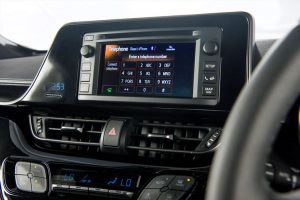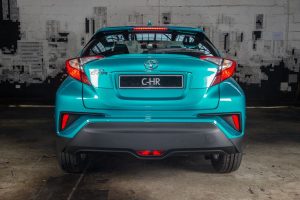
Historically, Toyota hasn’t exactly been known as the motor manufacturer with the most radical of ideas. With a few exceptions, their offerings have always leaned towards the conservative side, with rather generic styling and well-proven engineering. And that’s exactly what the greatest multitude of buyers want from their cars: sensible, considerate transport which will last a long time without being bothersome to own or operate. This approach is clearly very successful, as Toyota has grown to be one of the largest automakers in the world, jostling with giants Volkswagen and General Motors for market supremacy (and sometimes even snatching the top spot).
All of which makes it all the more remarkable that, back in 1994, this most conservative of companies came up with the Crossover SUV – an idea which forever changed the automotive landscape. The original Toyota RAV4 was a chubby-faced yet strangely gangly little soft-roader, and it broke all the rules of its time. While it may have looked vaguely off-roaderish (and some versions even sported all-wheel drive), it was really just a raised compact hatchback, based on the oily bits of a mid-range passenger car. 23 years later, this recipe has proved to be a guarantee for commercial success, and has been adopted by virtually all manufacturers.
Through the years, the “SUV” part of this segment’s label started to fade into insignificance, however. It seems like most manufacturers are now happy to accept that their crossovers are basically simply tall hatchbacks, with most of them eschewing all-wheel drive altogether in favour of simpler FWD-only drivetrains, especially in the smaller examples such as Mazda’s CX-3, Opel’s Mokka, Honda’s HR-V. And, with the RAV4 having evolved into a much larger vehicle over the years, it was time for Toyota to return to the compact crossover market and reclaim its heritage with a brand-new offering. Yes, it’s time for yet another three-letter acronym: meet the C-HR.
The marketing blurb seems unsure what C-HR is supposed to mean: it’s either Compact High Rider, Coupé High Rider or Cross(over) Hatch Runabout. No matter, as they all sort of describe the car. Built upon the Toyota New Global Architecture (TNGA) – a platform we’ve already met in the latest Prius and which is sure to underpin the next-generation Corolla and Auris – it takes Toyota’s latest technology and wraps it in a somewhat controversially-styled hatchback body before adding chunky wheel arch extensions and lower bodyside cladding to a raised stance.

So let’s talk about the elephant in the room: the body styling. It’s certainly distinctive, even if some of its proportions bring Nissan’s Juke to mind. The front end looks like the car is sucking in its cheeks while simultaneously biting its upper lip and squinting. The lower bumper defines a square jaw line, and various scoops and strakes feed air to the engine (or just add some more visual drama). The side profile is dominated by exaggerated wheel arches and a multitude of sharp creases and lines, while the rather small glass area has a leaf-shaped theme which swoops up to a somewhat abrupt end ahead of the rear wheel arches. The rear end is no less unusual, with a shallow window and intricately-shaped tailgate spoiler added to the obligatory folds and creases. It’s perhaps the modern car with the most noticeable origami (art created by folding paper) influences. There’s a lot going on, styling-wise, and it might take a while to fully appreciate, but the end result is surprisingly cohesive in spite of all the clutter on the surface. This is one Toyota which cannot be accused of boring, derivative styling, but it’s still screwed together with the perfect panel alignment and solid build quality we’ve come to expect from the brand.

Stepping inside, you’ll find a cabin design which is as soothing as the exterior styling is startling. The layout is simple and recognisably Toyota, but the soft-touch dashboard is nicer than anything this side of a Lexus. A horisontal emphasis creates a surprising impression of width for a compact car, but there are enough swoops and curves to keep it from looking bland. The multimedia system’s touch screen lives in a nicely integrated pod above the centre air vents, while the air conditioning controls live underneath. It’s all classy and premium-feeling inside, and the interior ambience easily steps ahead of the rest of its segment, with the possible exception of the equally lovely Mazda CX-3.

Given the C-HR’s price bracket, standard equipment is also reasonably generous. The audio system has the obligatory USB/Bluetooth/Apple integration, while air conditioning, electric windows and mirrors, stability control, and dual airbags are standard across the range. The up-spec “Plus” adds a colour multi-information display in the instrument cluster (operated by controls on one of the steering wheel spokes), remote audio controls (on another steering wheel spoke), cruise control, automatic headlights and wipers, an auto-dimming rear view mirror, and a dual-zone automatic climate control system. It’s all par for the course in this segment, although more airbags wouldn’t go amiss – which should eventually become available when higher-trim derivatives reach our shores.
Things get really interesting under that outrageously folded sheetmetal and plastic, though. Motive power comes from an engine which marks quite a step change for Toyota’s mainstream offerings, being a downsized turbo charged petrol unit – the first such Toyota-branded offering in many years, and only the company’s second in recent memory (the 2.0-litre turbo in various Lexus models being the first). It’s quite a high-tech little mill, with direct injection and a variable camshaft timing system which allows it to run in either a parsimonious Atkinson cycle or a power-productive Otto cycle. Whatever the technical intricacies, it works very well, and it’s decently responsive, smooth and quiet too. It extracts 85 kW and 185 Nm (the latter in a plateau from 1500 to 4000 r/min) from 1.2 litres of displacement, with an official average fuel consumption of either 6.3 ℓ/100 km when mated to the manual transmission (6.4 ℓ/100 km with the CVT).
Two transmission options are on offer: a 6-speed manual or a CVT, both only available with front wheel drive. The manual gearbox is a thing of joy, with a beautifully light and accurate gear shift action, alongside Toyota’s iMT rev-matching system to help the driver perform seamless gear changes. But for once, the buttery-smooth CVT might actually be more desirable, because it unobtrusively maximises propulsion from the little engine without feeling like it’s struggling with a slipping clutch. The CVT also minimises that trace of take-off lag evident just off idle, and makes driving in dense traffic absolutely painless.

The under-the-skin refinement extends to the suspension calibration, where the independent springing all round offers a really good blend of comfort and control. It’s no sports car, but the C-HR’s cornering behaviour is nonetheless confidence-inspiring, consistent and predictable, with well-controlled weight transfer through turns and responsive (if somewhat numb) electrically assisted steering. The C-HR also rides with real fluency, insulating the cabin from road shocks and smoothing over sharp road imperfections. It’s all perfectly matched to its role as a refined all-rounder, and should make the C-HR an excellent long-distance cruiser as well as an agile city car. Noise levels are equally well managed, with road- and engine noise being practically absent and only a whisper from the large side mirrors making itself heard at higher speeds.
Is the C-HR that elusive perfect car? Not quite. There are two slight chinks in its armour, and both relate to its greenhouse. Firstly, those exaggeratedly truncated side windows severely limit outward visibility for rear-seat occupants. With the trailing edge of the glass ending so far forward, and with its sharp upward slope, the back seat becomes a bit of a cave which will definitely suck a large amount of joy out of a visit to a game park. Those wide rear roof pillars, small glass area and elevated tail create the second problem, which is compromised sightlines when reversing. The rear three-quarter blind spots are quite massive, and the view out the rear windscreen is also extremely limited. Hopefully, Toyota will soon add blind spot monitoring, rear parking sensors and cross-traffic alert to the specification sheet. It’s nothing you can’t get used to, but the restricted visibility does strike a jarring note in an otherwise supremely agreeable car.
Apart from this single issue, the C-HR is really hard to fault. It presents all the traditional Toyota values of solid quality, decent practicality and good value, but in a very distinctively styled wrapping, with an extra shot of refinement and modern technology. Due to worldwide demand, South Africa is only allocated about 250 units of this Turkish-built crossover every month, and it’s almost certain that demand will outstrip supply by quite some margin for the time being. As with Turkish Delight sweets, the C-HR might not be to everybody’s taste, but for those buyers with a yearning for something a little more exotic, Toyota’s new Turkish delight presents everything they could wish for – including an artisinal origami wrapping for their delicacy.

Toyota C-HR Range:
Toyota C-HR 1.2T 6MT – R 318 500
Toyota C-HR 1.2T 6MT Plus – R 345 000
Toyota C-HR 1.2T CVT Plus – R 356 000
WARRANTY AND SERVICE PLAN
All C-HR models come standard with a comprehensive 5 year/90 000 km service plan, with service intervals set at 15 000 km. A 3 year/100 000 km warranty is provided.

